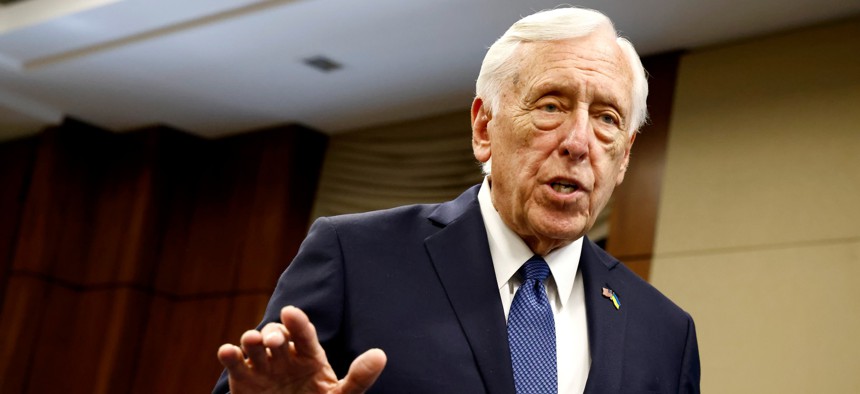$756M Still Left in TMF, But Not For Long

House Majority Leader Steny Hoyer, shown here at an April 2022 event on Capitol Hill, helped lead the initial push for the TMF during the Obama administration Paul Morigi/Getty Images
The administration plans to exhaust the $1 billion addition to the Technology Modernization Fund made under last year’s American Rescue Plan Act by the end of the current fiscal year.
The Technology Modernization Fund, a revolving pot of money set up by Congress to support information technology upgrades, has received about $1.175 billion since its inception in 2017, with the bulk of that coming in the form of a $1 billion plus-up in the American Rescue Plan Act in March of 2021.
Raylene Yung, executive director of the TMF at the General Services Administration, said in prepared testimony for a House hearing May 25 that the organization plans to "allocate all of the funds provided for the [American Rescue Plan Act] this [fiscal] year," which would leave the fund all but empty if further appropriations are not passed into law.
A chart displayed at the hearing of the Government Operations Subcommittee of the House Committee on Oversight and Reform indicated that so far $419 million in awards have been made since the fund was established in 2017, and there is $756 million left.
Now the administration is seeking $300 million in new money in the fiscal year 2023 budget for the TMF—with the support of members from both sides of the aisle and several leading technology trade associations.
However, concerns remain about how planned payback mechanisms are working and whether the fund is focused on the core IT modernization issues that were front and center in the Modernizing Government Technology Act legislation that authorized TMF.
David Hinchman, the acting director for information technology and cybersecurity at the Government Accountability Office, noted in his testimony that GSA's fee collection was failing to offset operating costs and that projects awarded through August 2021 "relied on savings estimates that were derived from cost estimates GAO found to be unreliable."
A key feature of TMF is that agencies are meant to repay the fund from savings realized on investments. The Biden administration relaxed TMF repayment requirements last May for projects that cut across multiple agencies or involved cybersecurity improvements. Hinchman testified that new guidelines allowed agencies to seek minimal or partial reimbursement options in their applications but that the TMF program management office has "not released the details of these reimbursement changes, nor any resulting impact on the collection of fees to offset TMF expenses."
In his opening remarks, Rep. Andy Biggs (R-Ariz.) suggested that the current operation of TMF was veering away from what he saw as the original focus of the law.
"It's unclear whether IT modernization as it pertains to retiring legacy systems is the primary focus on the TMF today—and it ought to be," Biggs said. "While the law does give latitude to the projects eligible for funding, recent awards exhibit a focus on other priorities such as customer experience and cybersecurity. It's not that those projects are not important, but they do point to a shift away from the savings-based model intended in the law."
Yung's testimony indicates that more awards focusing on helping agencies meet the demands of cybersecurity and customer experience executive orders are in the works.
"We work closely with the broader cybersecurity community to invest in projects and pilots that
help agencies across the federal enterprise adopt a zero-trust framework," Yung stated in prepared testimony. "The TMF is also well-positioned to make a large impact on federal customer experience by leveraging technology to improve life experiences that span agencies, as well as drive innovation across the High Impact Service Providers—those federal programs that impact the most customers, have the highest volume of annual transactions, or have an outsized impact on the lives of the people that we serve."
Yung also explained that "cost savings can come in many different ways," and detailed benefits from TMF projects that might not show up on agency balance sheets including "reducing costs to other groups," like customers and stakeholders who gain time-savings and efficiencies from the digitization of paper-based processes. She said that the TMF's work on helping the Department of Veterans Affairs transition to GSA's secure identity service Login.gov could save the agency "hundreds of millions of dollars—which would pay off the investment."
House Majority Leader Steny Hoyer (D-Md.), an original sponsor of the MGT Act, joined the hearing to suggest larger ambitions for the fund. He recalled that the original 2017 bill sought $3 billion for the fund and was modeled on a private sector budgeting practice developed by former Federal CIO Tony Scott when he was chief information officer of Microsoft.
He noted that the program was designed to "be effective at funding big systemic upgrades, not just small fixes," and tried to address concerns that some in Congress have had over allocating multi-year and no-year funds to the federal government to spend across agencies as it sees fit.
"I'm an appropriator. I served on the appropriations committee for 23 years. I understand the concerns that appropriators have about having annual appropriations so they can apply oversight to the use of the taxpayer's dollar," Hoyer said. "Having said that, however, what we have found is that the appropriations process is too slow to respond in a way that we need to respond. If the private sector responded as slowly as we did, they too would be out of date with their technology."






